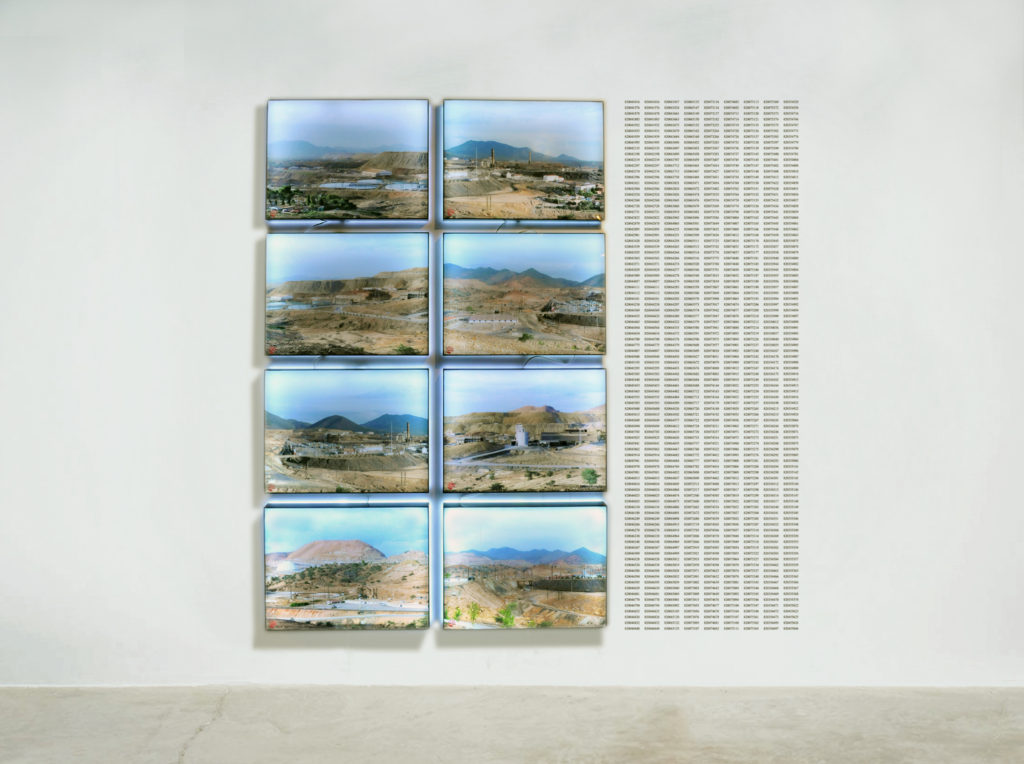850

Installation view at Museo de Arte Carrillo Gil, Mexico City, 1ra Bienal de Paisaje, 2015.
- Eight light boxes of landscape photographs of Cananea, the Latin America’s largest copper mining complex, owned by the mining company Grupo Mexico.
- List of union membership enrollment numbers of 850 miners fired by the company after holding a strike initiated by claims of job security, which lasted two and a half years, was not recognized by Grupo Mexico and the Mexican government, and was lastly crushed by police in 2010.
***
- Ocho cajas de luz con fotografías de paisaje de la mina de Cananea, la mina de cobre más grande de América Latina, propiedad de la compañía minera Grupo México.
- Listado de los números de filiación sindical de 850 mineros despedidos por sostener una huelga iniciada por reivindicaciones de seguridad laboral, que durara dos años y medio, y que fuese aplastada por la policía y desconocida por Grupo México y por el Estado Mexicano en 2010.
From the outside
“…. It is a faceless power that heavily suffocates every pore of life in the town. Here everything belongs to the Company. After the strike, the Company no longer hired people from the town, the strikers they did rehire were all fired once again. The children of the miners were expelled from the school owned by the Company. Nobody from the town remains in the mine, only the tertiary workers and people from outside, from the south. They live crowded in warehouses, work twelve-hour days. They do it for little salary, without a collective contract and without the minimum security conditions. Nobody can do anything in there, if you get organized you get fired. There are casualties, we know. They take them out from the rear of the mine, through the mountains to take them to Hermosillo, so that no one here notices. They closed the clinic, many old people who left their lungs in the mine are dying. Of us, those who are from here, nobody enters. We see it, but always from the outside, always from afar. People here now live with their backs to the mine.”
“…. Es un poder sin rostro que con peso de plomo asfixia cada poro de la vida en el pueblo. Aquí todo pertenece a la Compañía. Después de la huelga, la Compañía ya no contrató a gente del pueblo, a los huelguistas que recontrataron ya los despidieron a todos. A los hijos de los mineros los expulsaron de la escuela propiedad de la Compañía. En la mina no queda nadie del pueblo, sólo los ‘terciarios’ y gente de fuera, del sur. Viven hacinados en galerones, trabajan jornadas de doce horas. Lo hacen por poco sueldo, sin contrato colectivo y sin las condiciones mínimas de seguridad. Nadie puede hacer nada allí dentro, si te organizas te despiden. Hay muertes, lo sabemos. Los sacan por otro lado, por la montaña para llevarlos a Hermosillo, para que aquí nadie se dé cuenta. Cerraron la clínica, muchos viejos que dejaron los pulmones en la mina se están muriendo. De nosotros, los de aquí, nadie entra. La vemos, pero siempre desde afuera, siempre desde lejos. La gente de aquí ahora vive de espaldas a la mina.”
*Los textos que la pieza incluye se toman del artículo ‘La interminable huelga de los mineros mexicanos de Cananea:¿El final de un régimen laboral?’ de Juan Luis Sariego. Amérique Latine Histoire et Mémoire. Les Cahiers ALHIM 26 | 2013: Réalités et défis du syndicalisme en Amérique latine. http://alhim.revues.org/4789.













